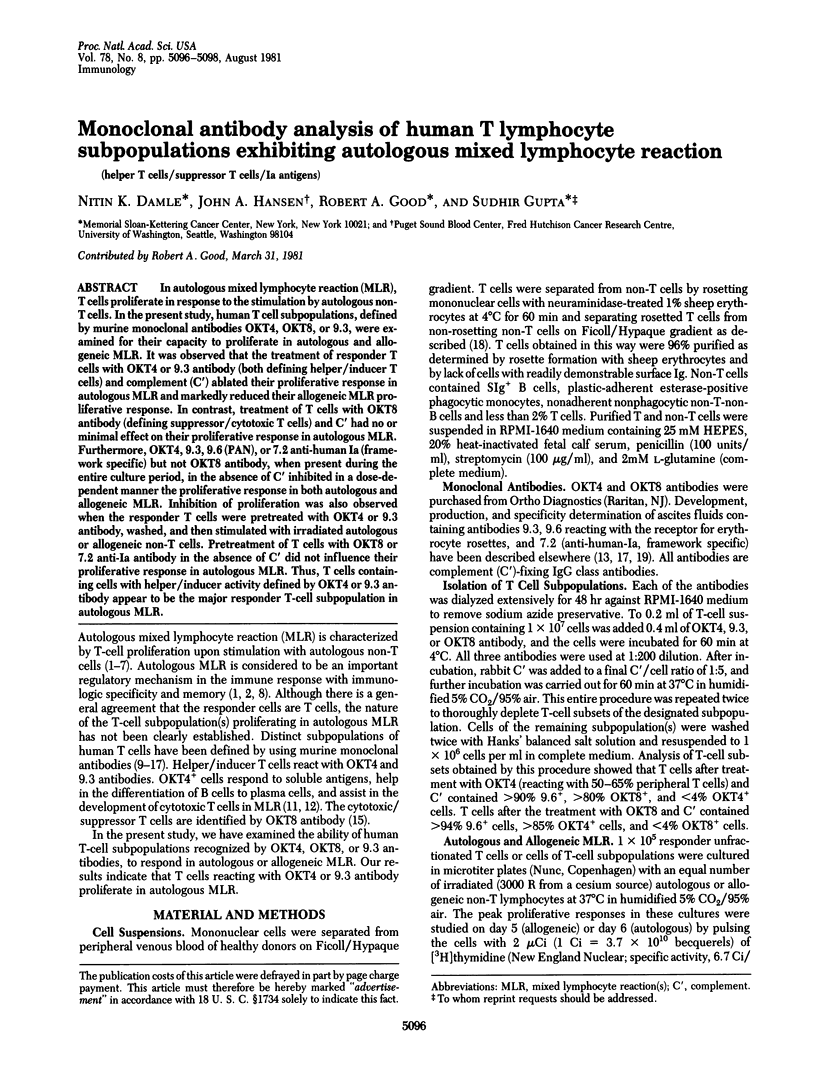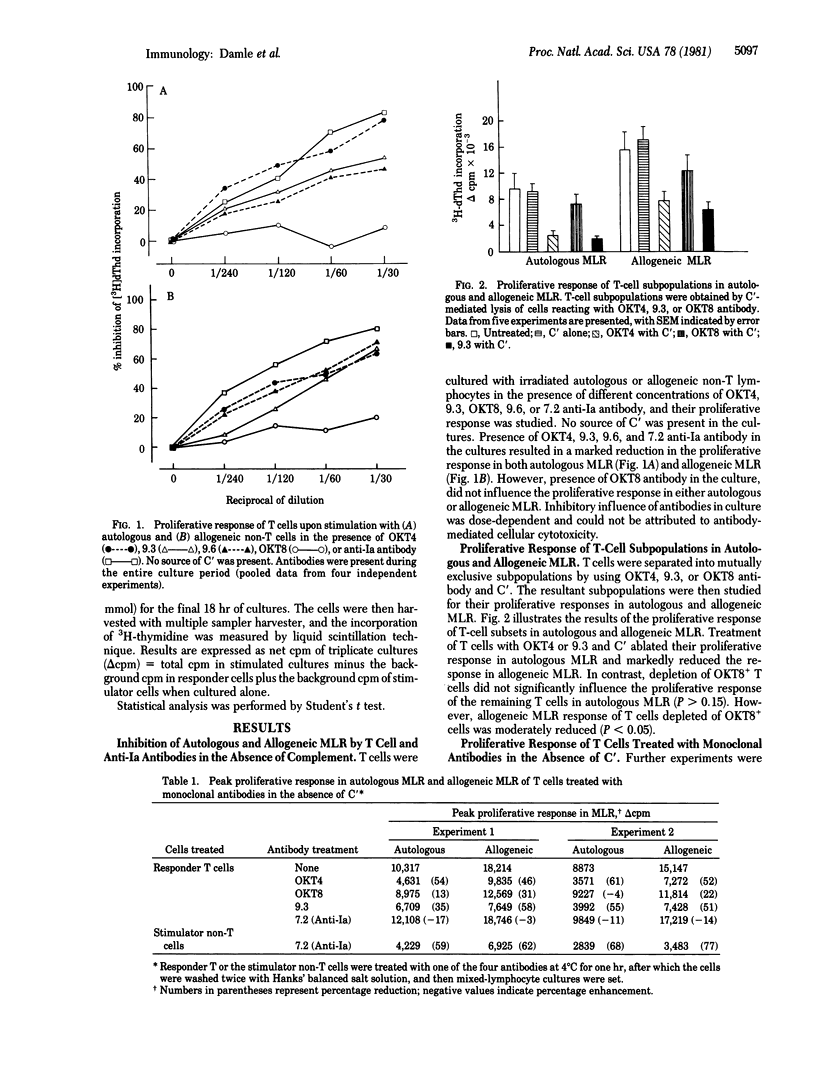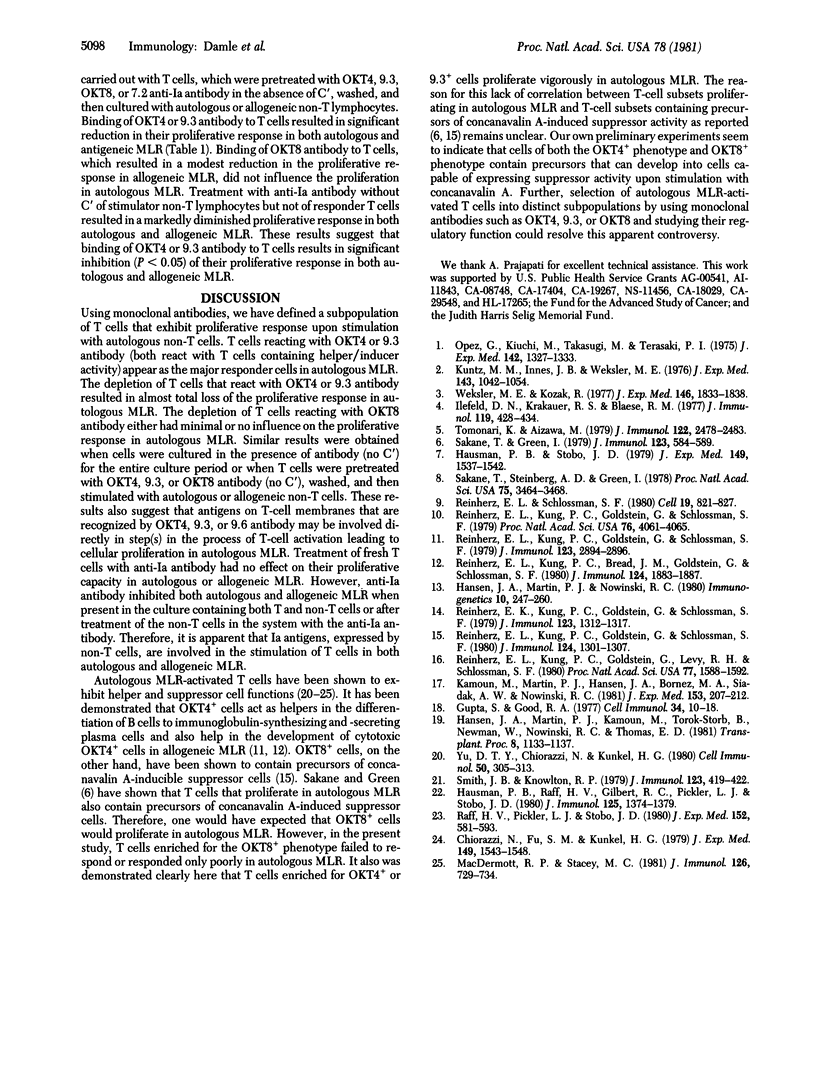Abstract
In autologous mixed lymphocyte reaction (MLR), T cells proliferate in response to the stimulation by autologous non-T cells. In the present study, human T cell subpopulations, defined by murine monoclonal antibodies OKT4, OKT8, or 9.3, were examined for their capacity to proliferate in autologous and allogeneic MLR. It was observed that the treatment of responder T cells with OKT4 or 9.3 antibody (both defining helper/inducer T cells) and complement (C') ablated their proliferative response in autologous MLR and markedly reduced their allogeneic MLR proliferative response. In contrast, treatment of T cells with OKT8 antibody (defining suppressor/cytotoxic T cells) and C' had no or minimal effect on their proliferative response in autologous MLR. Furthermore, OKT4, 9.3, 9.6 (PAN), or 7.2 anti-human Ia (framework specific) but OKT8 antibody, when present during the entire culture period, in the absence of C' inhibited in a dose-dependent manner the proliferative response in both autologous and allogeneic MLR. Inhibition of proliferation was also observed when the responder T cells were pretreated with OKT4 or 9.3 antibody, washed, and then stimulated with irradiated autologous or allogeneic non-T cells. Pretreatment of T cells with OKT8 or 7.2 anti-Ia antibody in the absence of C' did not influence their proliferative response in autologous MLR. Thus, T cells containing cells with helper/inducer activity defined by OKT4 or 9.3 antibody appear to be the major responder T-cell subpopulation in autologous MLR.
Full text
PDF


Selected References
These references are in PubMed. This may not be the complete list of references from this article.
- Chiorazzi N., Fu S. M., Kunkel H. G. Induction of polyclonal antibody synthesis by human allogeneic and autologous helper factors. J Exp Med. 1979 Jun 1;149(6):1543–1548. doi: 10.1084/jem.149.6.1543. [DOI] [PMC free article] [PubMed] [Google Scholar]
- Gupta S., Good R. A. Subpopulations of human T lymphocytes. II. Effect of thymopoietin, corticosteroids, and irradiation. Cell Immunol. 1977 Nov;34(1):10–18. doi: 10.1016/0008-8749(77)90224-6. [DOI] [PubMed] [Google Scholar]
- Hansen J. A., Martin P. J., Kamoun M., Torok-Storb B., Newman W., Nowinski R. C., Thomas E. D. Monoclonal antibodies recognizing human T cells: potential role for preventing graft-versus-host reactions following allogeneic marrow transplantation. Transplant Proc. 1981 Mar;13(1 Pt 2):1133–1137. [PubMed] [Google Scholar]
- Hausman P. B., Raff H. V., Gilbert R. C., Picker L. J., Stobo J. D. T cells and macrophages involved in the autologous mixed lymphocyte reaction are required for the response to conventional antigen. J Immunol. 1980 Sep;125(3):1374–1379. [PubMed] [Google Scholar]
- Hausman P. B., Stobo J. D. Specificity and function of a human autologous reactive T cell. J Exp Med. 1979 Jun 1;149(6):1537–1542. doi: 10.1084/jem.149.6.1537. [DOI] [PMC free article] [PubMed] [Google Scholar]
- Ilfeld D. N., Krakauer R. S., Blaese R. M. Suppression of the human autologous mixed lymphocyte reaction by physiologic concentrations of hydrocortisone. J Immunol. 1977 Aug;119(2):428–434. [PubMed] [Google Scholar]
- Kamoun M., Martin P. J., Hansen J. A., Brown M. A., Siadak A. W., Nowinski R. C. Identification of a human T lymphocyte surface protein associated with the E-rosette receptor. J Exp Med. 1981 Jan 1;153(1):207–212. doi: 10.1084/jem.153.1.207. [DOI] [PMC free article] [PubMed] [Google Scholar]
- Kuntz M. M., Innes J. B., Weksler M. E. Lymphocyte transformation induced by autologous cells. IV. Human T-lymphocyte proliferation induced by autologous or allogeneic non-T lymphocytes. J Exp Med. 1976 May 1;143(5):1042–1054. doi: 10.1084/jem.143.5.1042. [DOI] [PMC free article] [PubMed] [Google Scholar]
- MacDermott R. P., Stacey M. C. Further characterization of the human autologous mixed leukocyte reaction (MLR). J Immunol. 1981 Feb;126(2):729–734. [PubMed] [Google Scholar]
- Opelz G., Kiuchi M., Takasugi M., Terasaki P. I. Autologous stimulation of human lymphocyte subpopulation. J Exp Med. 1975 Nov 1;142(5):1327–1333. doi: 10.1084/jem.142.5.1327. [DOI] [PMC free article] [PubMed] [Google Scholar]
- Raff H. V., Picker L. J., Stobo J. D. Macrophage heterogeneity in man. A subpopulation of HLA-DR-bearing macrophages required for antigen-induced T cell activation also contains stimulators for autologous-reactive T cells. J Exp Med. 1980 Sep 1;152(3):581–593. doi: 10.1084/jem.152.3.581. [DOI] [PMC free article] [PubMed] [Google Scholar]
- Reinherz E. L., Kung P. C., Breard J. M., Goldstein G., Schlossman S. F. T cell requirements for generation of helper factor(s) in man: analysis of the subsets involved. J Immunol. 1980 Apr;124(4):1883–1887. [PubMed] [Google Scholar]
- Reinherz E. L., Kung P. C., Goldstein G., Levey R. H., Schlossman S. F. Discrete stages of human intrathymic differentiation: analysis of normal thymocytes and leukemic lymphoblasts of T-cell lineage. Proc Natl Acad Sci U S A. 1980 Mar;77(3):1588–1592. doi: 10.1073/pnas.77.3.1588. [DOI] [PMC free article] [PubMed] [Google Scholar]
- Reinherz E. L., Kung P. C., Goldstein G., Schlossman S. F. A monoclonal antibody reactive with the human cytotoxic/suppressor T cell subset previously defined by a heteroantiserum termed TH2. J Immunol. 1980 Mar;124(3):1301–1307. [PubMed] [Google Scholar]
- Reinherz E. L., Kung P. C., Goldstein G., Schlossman S. F. A monoclonal antibody with selective reactivity with functionally mature human thymocytes and all peripheral human T cells. J Immunol. 1979 Sep;123(3):1312–1317. [PubMed] [Google Scholar]
- Reinherz E. L., Kung P. C., Goldstein G., Schlossman S. F. Further characterization of the human inducer T cell subset defined by monoclonal antibody. J Immunol. 1979 Dec;123(6):2894–2896. [PubMed] [Google Scholar]
- Reinherz E. L., Kung P. C., Goldstein G., Schlossman S. F. Separation of functional subsets of human T cells by a monoclonal antibody. Proc Natl Acad Sci U S A. 1979 Aug;76(8):4061–4065. doi: 10.1073/pnas.76.8.4061. [DOI] [PMC free article] [PubMed] [Google Scholar]
- Reinherz E. L., Schlossman S. F. The differentiation and function of human T lymphocytes. Cell. 1980 Apr;19(4):821–827. doi: 10.1016/0092-8674(80)90072-0. [DOI] [PubMed] [Google Scholar]
- Sakane T., Green I. Specificity and suppressor function of human T cells responsive to autologous non-T cells. J Immunol. 1979 Aug;123(2):584–589. [PubMed] [Google Scholar]
- Sakane T., Steinberg A. D., Green I. Failure of autologous mixed lymphocyte reactions between T and non-T cells in patients with systemic lupus erythematosus. Proc Natl Acad Sci U S A. 1978 Jul;75(7):3464–3468. doi: 10.1073/pnas.75.7.3464. [DOI] [PMC free article] [PubMed] [Google Scholar]
- Smith J. B., Knowlton R. P. Activation of suppressor T cells in human autologous mixed lymphocyte culture. J Immunol. 1979 Jul;123(1):419–422. [PubMed] [Google Scholar]
- Tomonari K., Aizawa M. Induction of autoreactive cells by the preculture of human peripheral blood mononuclear cells with the autologous fresh plasma. J Immunol. 1979 Jun;122(6):2478–2483. [PubMed] [Google Scholar]
- Weksler M. E., Kozak R. Lymphocyte transformation induced by autologous cells. V. Generation of immunologic memory and specificity during the autologous mixed lymphocyte reaction. J Exp Med. 1977 Dec 1;146(6):1833–1838. doi: 10.1084/jem.146.6.1833. [DOI] [PMC free article] [PubMed] [Google Scholar]
- Yu D. T., Chiorazzi N., Kunkel H. G. Helper factors derived from autologous mixed lymphocyte cultures. Cell Immunol. 1980 Mar 15;50(2):305–313. doi: 10.1016/0008-8749(80)90285-3. [DOI] [PubMed] [Google Scholar]


